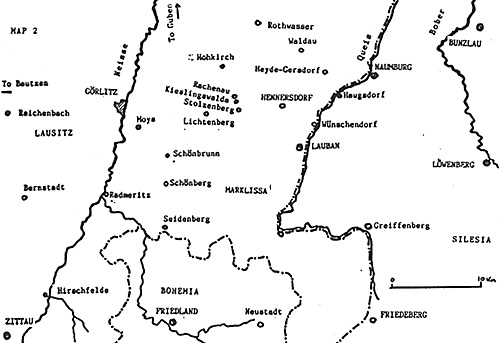 Operations In The Lausitz
Operations In The Lausitz
The area of the action was cut by three parallel rivers flowing northwards towards the Oder from the mountains along the Bohemian frontier to the south. The most westerly was the Neisse which left the mountains at Zittau and flowed north via Gorlitz. About 20km to the east across rolling, wooded hills lay the parallel valley of the Queis. Flowing north via Lauban and Naumburg, this formed the Lausitz-Silesian frontier. A further 10 to 20km eastwards lay the Bober valley and the Prussian outposts between Lowenberg and Bunzlau. (See Map 2).
MAP 2; Operations in the Lausitz. Frederick's Prussians would cross the Queis at Naumburg and encounter the Saxon Auxilliary Corps at Hennersdorf.
The Saxons had been collecting supplies at Zittau and Gorlitz in the south and at Guben, over 90km further north, since early November. The first two points were to provide for Charles' initial advance, while Guben was to act as his forward base for his drive on Frankfurt/Oder. To reach Guben, Charles had to march down either the Neisse or Queis valleys and so pass along the front of the Prussian army lurking beyond the Bober.
Charles was by now decidedly lukewarm about the entire project. Already opposed to the invasion plan due to the lateness of the season, he was further alarmed by reports reaching him since November 17 of the Prussian concentration beyond the Bober. Although he resolved to advance on schedule, he wished to move slowly to give Rutowski time to join him. A series of diversionary attacks by irregulars were launched at Prussian posts along the Bohemian-Silesian frontier, covering the main force as it left its base at Friedland and entered the Lausitz on Saturday November 20.
The Saxon auxiliary corps moved forward to secure the Queis and protect the Austrians as they marched along the eastern (Queisward) bank of the Neisse. Major General Buchner occupied Katholisch-Hennersdorf close to the Queis with three cuirassier regiments. Polenz held the villages of Stolzenberg, Kieslingswalda and Rachenau a little to the west with six infantry battalions. Two "pulks" of Ulans (Polish lancers) patrolled the river banks along the line Lauban-Marlissa-Greiffenberg.
Realizing that he must be close to the enemy, Buchner requested reinforcements. Polenz sent two of his battalions which arrived on November 22, but nothing further was done to strengthen the thin screen along the river, occupy Naumburg or destroy its vital bridge. Even though the outposts reported the Prussians as actually crossing the Queis that day, nothing was done to pull the Austrians togeather. Charles men remained dangerously scattered in a line of villages about 10km west of the Queis. Prince Lobkowitz and the advance guard around Kieslingswalds and Lichtenberg were nearly 10km north of the rearguard at Schonberg. Charles was with the center at Schonbrunn. On receiving the reports he rode towards Lauban on the 23rd to investigate, but could not see anything because of the mist. In the meantime Buchner was taken by surprise at Hennersdorf.
The Prussian Advance
Winterfeldt sent word early on the 22nd that the Austrians had definietly entered the Lausitz. This was the signal Frederick had been waiting for. Immediately, hebegan moving towards the Bober between Bunzlau and Lowenberg, ordering the pontoons forward to Naumburg, where there was already a permanent bridge flanked by two fords. The Prussians began to arrive at the town by 11:00 A.M. on the 23rd by which time the pontoon bridge was complete. They started crossing in four columns two hours later, unopposed save for some skirmishing with the Ulans. The Prussian cavalry crossed by the fords and drove off the Ulans, pursuing them at full speed. With Zieten's ferocious hussars hot on their tails, the Ulans' only concern was to disappear into the thickly wooded countryside. No one bothered to warn Buchner. After crossing continuously for four hours, all 35,000 Prussians were over the Queis by 5:00 P.M.
Meanwhile, Zieten had pushed on ahead with two hussar regiments (Zieten and Ruesch) towards Hennersdorf where the Saxons were believed to be. His guide, a millar lad, led him in the mist to a hollow which he knew as a cattle pasture, but in this season was waterlogged. By luck Zieten found a way around it, for the Saxons, thinking it impassable, had left it unguarded. Though the mist had cleared by the time he approached the village, the thick woods screened his advance.
Battle of Hennersdorf
- The Winter Campaign of 1745, Saxon Involvement, and Rutowski's Plans
Operations In The Lausitz and The Prussian Advance
Surprise at Hennersdorf
Orders of Battle
Hennersdorf Jumbo Map (slow: 122K)
Back to Seven Years War Asso. Journal Vol. VII No. 1 Table of Contents
Back to Seven Years War Asso. Journal List of Issues
Back to Master Magazine List
© Copyright 1993 by James Mitchell
This article appears in MagWeb.com (Magazine Web) on the Internet World Wide Web.
Other articles from military history and related magazines are available at http://www.magweb.com